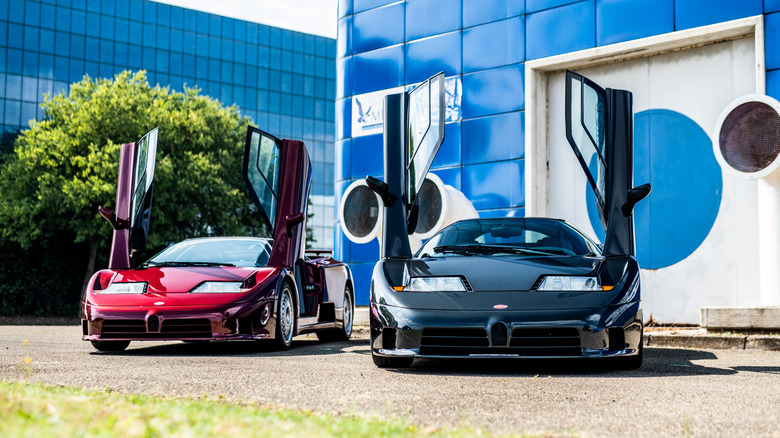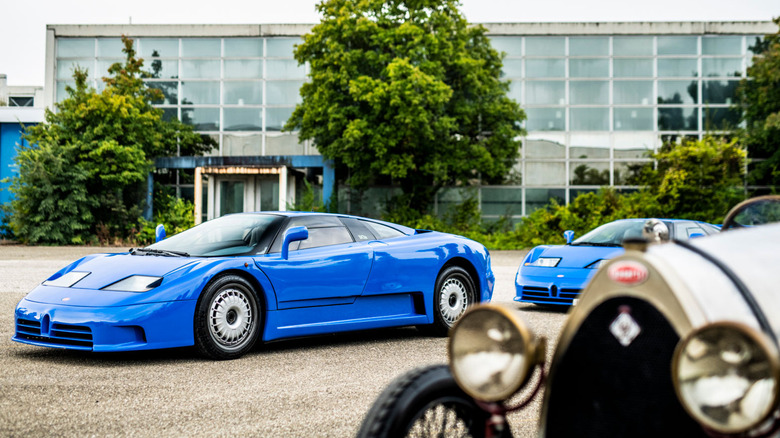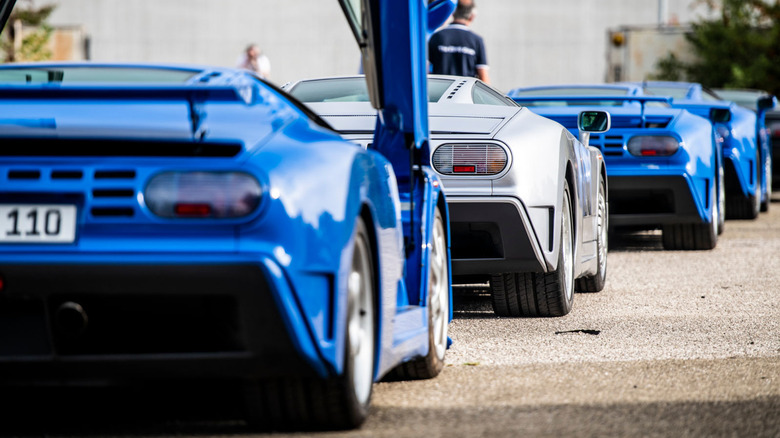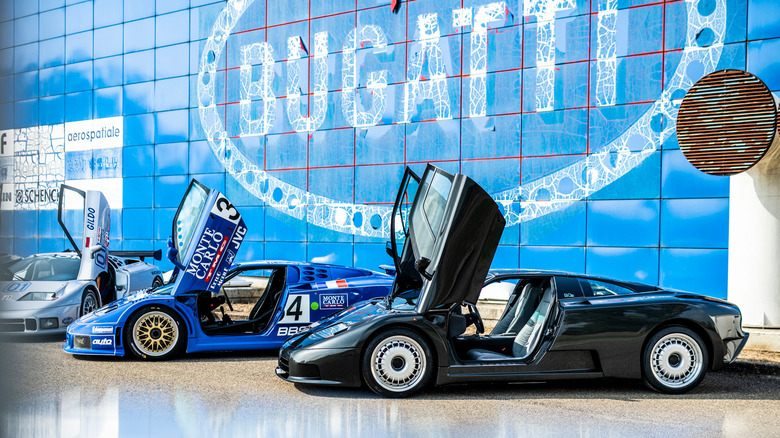How An Ambitious Bugatti Supercar Led To The Company's Bankruptcy
Bugatti calls the EB 110 "the first super sports car of the modern era," a no-compromise hypercar that bankrupted the automaker a few years after debuting on company founder Ettore Bugatti's 110th birthday (hence the EB 110 name) on September 15, 1991. Ettore Bugatti started making production cars in 1909, and the Bugatti brand had a successful racing career throughout the decades after World War I. After Ettorre's son, Jean, died in an accident in 1939, Nazi Germany invaded Alsace and demanded that Bugatti's factories produce torpedoes and cars for their army. Ettore refused and managed to flee to safety in Paris. Etorre died on August 21, 1947, and the Bugatti brand ceased operations by 1952.
There were attempts to revive the Bugatti name throughout the 1960s and 1970s, but it wasn't until 1987 when Italian entrepreneur Romano Artioli acquired the Bugatti brand. The acquisition made way for the birth of Bugatti Automobili S.p.A. and the new company's first and only car, the legendary EB 110. Artioli built a brand-spanking-new factory in Campogalliano, Italy, and immediately started working on the EB 110.
However, Bugatti faced financial difficulties when the EB 110 went public due to a global economic crisis, the Gulf War, overspending after Artioli acquired British automaker Lotus, and testing the follow-up to the EB110: The magnificent EB 112 four-door super sedan. The automaker also dealt with allegations of corporate espionage in which Artioli claimed three Bugatti directors were receiving money from rival carmakers, as recounted in a 2019 Classic Driver interview. Bugatti only made 134 examples of the EB 110 (of which 95 were GTs and 39 in SS trim) until closing the factory doors in September 1995.
The Bugatti EB 110 came at the wrong time
Romano Artioli pulled all the stops to make the Bugatti EB 110 legendary as the automaker's pre-war creations. Artioli knew beforehand that development for the EB 110 would cost a fortune, but he was willing to risk it all to honor the Bugatti legacy. Etorre Bugatti may have started making cars in Molsheim, but he was born in Milan, Italy. Artioli is Italian, too, and relocating the Bugatti factory to Italy gave the once-ailing marque a renewed sense of national pride.
"We couldn't play it safe. In order to honor Ettore Bugatti, we simply had to push the boundaries. The number of cars wasn't so important to me, but rather the no-compromise quality and innovation," said Artioli in a Classic Driver interview. "Throughout the entire project, I always followed Ettore's 'Nothing is too beautiful, nothing too expensive' philosophy." The mantra may have cost Bugatti a premature exit after the recession, but Artioli ended up with a masterpiece with the EB 110. Artioli assembled an all-star team of designers and engineers led by Paolo Stanzani and Marcello Gandini in conceptualizing the EB 110 prototype. However, Artioli didn't like Gandini's early designs and found them too angular.
The boss was also unimpressed with the prototype's aluminum honeycomb chassis, which he found too cumbersome for an all-conquering supercar. After clashing with the boss, both men handed over their resignation letters, and Artioli hired Gianpaolo Benedini and Nicola Materazzi to fix the problems.
Quad-turbocharged V12 engine
After multiple design alterations and engineering adjustments, the Bugatti EB 110 design and engineering team ended up with a smoother and more rounded sports car prototype with fixed headlamps, cooling ducts in the front bumper, and the Bugatti horseshoe grille front and center. Materazzi retained the scissor doors, side windows, and panoramic windshield. It also has a new carbon-fiber monocoque chassis, an all-wheel drivetrain, titanium bolts, and active aero — elements you wouldn't usually find in a '90s supercar.
The beating heart is a monstrous, rear-mounted 3.5-liter V12 engine with 60 valves, 12 throttle bodies, four turbochargers, and an 8,250 rpm redline. That breathtaking engine sends power to all four wheels using a six-speed manual transmission. Pumping out 553 horsepower and 451 pound-feet of torque, the EB 110 had an excellent power-to-weight ratio of 353 bhp/ton, allowing it to blitz from zero-to-60 mph in 3.3 seconds and a 212 mph top speed.
Bugatti also made a track variant of the EB 110. Affectionately called the Super Sport or SS (the EB 110 GT is the standard car), it had the same 3.5-liter quad-turbo V12 as the GT but with 611 horsepower and 480 pound-feet of torque, numbers that were unheard of back in the day. With those numbers, the EB 110 instantly became the fastest series-production car the world had ever seen, but the McLaren F1 broke the EB 110's speed record to claim the crown not long after.
The premature end of an era
While other elements may have had a hand in Bugatti's fall from grace, it seems clear that this dedication to quality and insistence on embodying Ettore's philosophy led to the business's bankruptcy. Moreover, the EB 110 had a base price of 450 million Italian lira (around $200,000) when it debuted in 1991, while the EB 110 SS version had a 550 million lira ($240,000) price tag. Those figures are ridiculous in a recession, so Bugatti made fewer cars than initially planned, since demand was almost non-existent for a costly sports car.
German racing firm Dauer bought the EB 110 license and all remaining parts in 1997 and produced five more cars. Volkswagen purchased Bugatti in 1998 and forever changed the automotive landscape with the Veyron and Chiron. In 2019, Bugatti paid homage to the EB 110 with the Centodieci, a Chiron with vintage styling, a 1,600 horsepower quad-turbo W16 engine, and a whopping $9 million base price.
The Bugatti EB 110 was more a victim of circumstance than shoddy engineering. It may have been too expensive for its time, but it showcased the future of Bugatti with its carbon monocoque chassis, all-wheel drivetrain, and quad-turbo engine.



